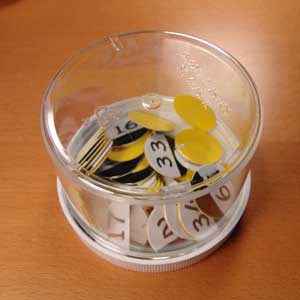

![]()
When I use Pick-A-Student to randomly select a student helper, should I call out the student's name or the student's number?
You can really use either one. Although we'd like to keep things as personalized as possible by using first names, students don't really have a problem hearing their numbers called out. This is especially true if the number being called is yours and it means you've been chosen to help out. Bingo!
While you're at it, you could even add to their growing number awareness by being a bit playful when you call out the number.

Teacher
Looking at the numbered tokens in the jar:
I see a number.
Pause.
It's an odd number.
Students are starting to buzz a little.
It's a rather large odd number.
Their anticipation is growing.
It's 33!Students
Doing the math on which student was assigned that number:
Stephanie!
![]()
I work in a continuation school with a revolving door. Although my class size runs anywhere from 9 to 22, it seems as if I'm always getting new students or losing current ones. However, some of them do stick around for the entire semester. I'm wondering if I should try using student numbers. My concern is that the changing population is going to make it difficult to remember which student has been assigned which number. Honestly, I don't need more confusion in my room; I need less.
A coupla-three thoughts.
1. I started using student numbers in a school located next to a navy housing area. I would gain or lose a student every two to three weeks. By the end of the year I'd have maybe five of my original September students still with me. The rest had come or gone during the course of the year.
The numbers, though, saved me a ton of work. Since everything in the room was number-based, I didn't have to continually change or update labels on folders or names on cubbies. The numbers proved to be the one constant throughout the school year.
2. With a changing class poplulation, you're going to need some kind of way to easily remember which student has which number. I suggest you either make a large roster and hang it on the wall or use a Binder Stand to display the information. Having the name/number info accessible will help to eliminate the uncertaintly of who's what.
3. The fact that you are working with a continuation school population grants you license to try new ideas. After all, they're in your class because traditional school strategies did not meet their needs. You've got nothing to lose--and everything to gain--by trying something different.
![]()
I have kind of a funny schedule with my students. I only have half of them for the first two hours of school. Then the other half joins us and I have all of them for two hours. After that, the first group leaves and I have the second group for two hours. How do I apply student numbers in this situation?
My first thought was: student numbers almost always work regardless of the situation. It's just going to take a bit of tweaking to fit this teacher's particular need. However, before I had a chance to offer my suggestion, the teacher who had asked the question answered it.
Teacher: Maybe I should use odd numbers for the first group and even numbers for the second group.
Sounds good to me.
By doing it this way, students would be able to use all of the number tools and toys that can be created to take advantage of the power of student numbers. And the teacher would know, for example, that for the first two hours of her day she would only need to see odd numbers marked off on a Check Off List or check to see that the odd-numbered clothespins had been removed from the box lid and placed in the coffee can. Conversely, for the last two hours of the day, she'd be checking to see that the even numbers were being processed.
Nice idea.
